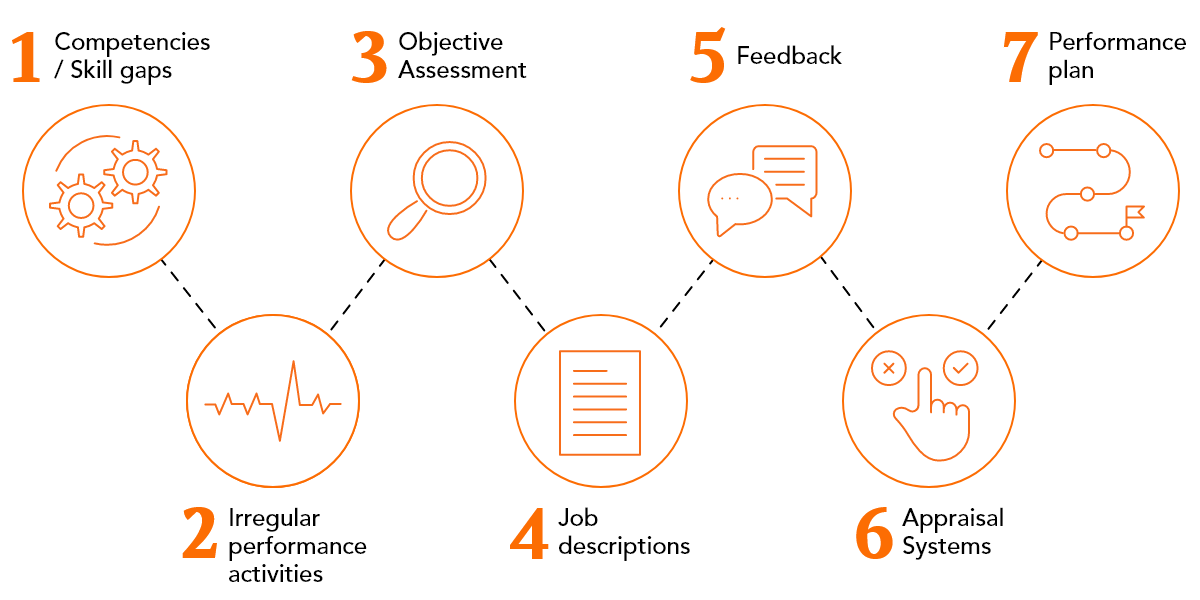Common-Sense Solutions For Performance Management
Performance and performance management is a major challenge in today’s workforce. Issues with performance management lead to tremendous financial losses globally, for businesses of all sizes, and across every sector. Even more concerning is the fact that, if left unmanaged, problems with performance often lead to loss of competitiveness within entire industries.
In this article, we’ll outline the 7 most common problems with performance management, and we’ll discuss solutions that companies can implement to mitigate those issues.
What Is Performance Management?
At a very macro level, performance management represents the approaches, processes, procedures, tools, and techniques employed by businesses to monitor, assess, and enhance employee performance across the organisation. The primary goals of performance management are to:
- Increase employee efficiency
- Enhance organisational productivity
- Maintain and sustain competitiveness
- Reduced input time and cost
- Improve profitability
- Discourage high employee turnover
The ultimate result of accomplishing these goals is about understanding employee motivation, supporting development, and helping them find the best path forward—which can be within the organisation or outside of it. However, problems with performance management systems—IT-driven or manual workflow-based—can seriously impact an organisation’s sustained ability to create productive workforces that deliver optimal performance. Let’s review some common performance management problems and possible solutions that’ll put organisations on a path to better performance.
7 Common Problems With Performance Management
Organisational performance management systems are the best way to measure and manage employee performance. However, not all businesses have performance management software that either works well or delivers optimal value to the company. Here are 7 common issues with performance management systems to focus on:
1. Competencies/Skills Gaps
Organisations are unaware of the skills gaps in individuals, positions, or groups that they manage. As a result of this lack of awareness, managers are often blind to the skills possessed by their employees and those needed by the organisation.
2. Irregular Performance Activities
There is a lack of regular performance review and management activity. As a result, organisations remain unaware of performance issues festering or entrenched within the workforce – until the next scheduled performance appraisal.
3. Lack Of Objective Assessment
Too often, employee performance is left to the opinions of a manager. Needless to say, even the most effective manager’s objectivity may be questioned if they deliver less than glowing evaluations.
4. Irrelevant Job Descriptions
In most organisations, the job description is the primary tool against which performance is measured and managed. With irrelevant or vague job descriptions, employees are left guessing what their performance expectations are, and managers struggle with managing those vague expectations.
5. Inadequate Feedback
It’s insufficient as a performance management measure to only let employees know how well or poorly they perform. Feedback must not only review and highlight performance gaps, but must also include clear paths to performance improvement.
6. Inadequacy Of Formal Appraisal Systems
One issue with performance management systems is that they are often too formal. These systems are inadequate because they are typically scheduled as an annual or biannual process and often conducted using a template/cookie-cutter-based system. Overreliance on solely formal appraisal systems is often inadequate when it comes to timely and in-the-flow-of-work performance management.
7. Absence Of A “Plan” For Addressing Below-Standard Performance
Highlighting performance gaps is of no value unless there’s a plan to address those gaps. Lack of a performance improvement plan leads to a wasted performance management opportunity.
Addressing these issues can not only lead to improved manager and employee performance but can also result in enhanced organisational performance. But how do companies address these challenges?
The Road To Better Performance Management
Here are some common-sense solutions to the performance management challenges discussed above:

- Competencies/Skills gaps – Competency gaps must be highlighted for improvement and better performance management, and then proactively addressed. Appraisers may suggest more training, better supervision, or even assign coaches and mentors to address such gaps.
- Irregular performance activities – As part of a robust performance management process, frequent appraisals, check-ins, and other feedback are essential. Don’t restrict performance improvement feedback to just annual/biannual cycles. Real-time feedback (in-the-flow-of-work) management (observe, instruct, encourage, coach, and evaluate) can lead to better performance at all levels.
- Lack of objective assessment – Suggested tools to address objectivity in assessments include implementing systems such as 360-degree appraisal, on-the-job-assessment, management by objectives, peer reviews, and trait/behaviour-based appraisals.
- Irrelevant job descriptions – Clearly explain an employee’s role within a team and the larger organisation, discuss performance expectations, and ensure clarity around how performance is measured. As part of the job definition, set achievable and measurable (SMART) performance objectives. Link company goals to an individual’s job description and their performance against those descriptions.
- Inadequate feedback – The root cause of such inadequacy often lies in either cursory feedback (“Needs improvement” or “Work on communicating better”), or providing feedback long after a potentially “teachable moment” has passed. Giving concise yet clear feedback, and across a broad spectrum of performance metrics, is a great way to address this issue.
- Inadequacy of formal appraisal systems – Performance management shouldn’t be primarily a “timed” or overly formalised process. When managers and supervisors act as front-line coaches, or “in the flow of work” or “in the moment” performance appraisers, their actions will have a significantly better impact on performance than the biannual or annual systems of measurement.
- Absence of a “plan” for below-standard performance: As part of a performance management plan, implement a robust performance support system. Components of the plan include consultations and counseling, recommendations for additional training, suggesting refresher courses, continuous skills improvement, or assigning mentors.
Organisational performance (i.e., profitability, competitiveness, brand loyalty, reputation, pricing power, market share growth) depends on a high-performing workforce. And getting employees to perform at optimal levels depends on better management of that performance. If supervisors don’t do a good job at performance management or if inherent problems with performance management systems are continually ignored, organisations may also lose talented and experienced employees to the competition.

Originally published at kineo.com.

